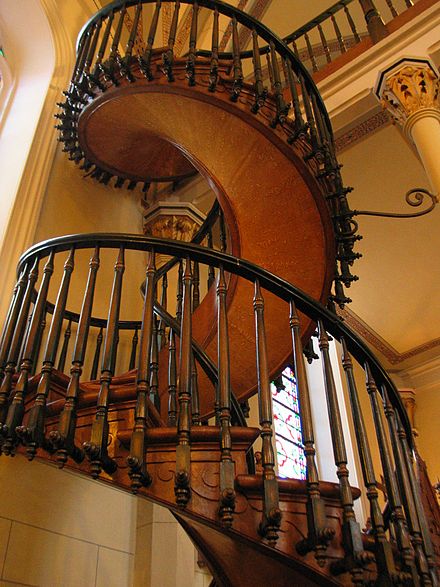The Loretto Chapel in Santa Fe, New Mexico was constructed in 1878. However, French architect Projectus Mouly died unexpectedly before a staircase could be completed to the choir loft twenty feet above the floor. That was a big problem because nobody else knew how to make a way up there. Local builders suggested using a long ladder to reach the choir loft, but the nuns responsible for Loretto Chapel weren’t interested in climbing a ladder while wearing a habit.

Allegedly the Sisters of Loretto had consulted with every builder in the area to find someone suitable to complete the project, but no one proposed a workable solution given the confined spaces involved and didn’t require a ladder. Legend has it that the nuns then prayed a special prayer called a novena for nine straight days to St. Joseph (the patron saint of carpenters) and on the final day of the prayer, a mysterious man rode out of the desert on a donkey, offering to build the staircase on one condition — no one could watch him work. Several months later, the project was completed, and as the story goes, that mysterious carpenter vanished as quickly as he appeared, without accepting any payment for his labor or the materials used to construct this architectural masterpiece.
However, if a story sounds a little too good to be true, it’s probably been embellished. While it is often difficult to separate fact from fiction, the documented facts include an entry in a nun’s daybook dating back to 1881 claims that a man named Rochas was paid for wood. We might reasonably assume the wood purchased was used to construct the staircase, although the entry in the daybook doesn’t specify a purpose. An article from The New Mexican claimed that Francois-Jean Rochas was the very skilled craftsman who came from France to design and build the staircase with exceptional skill, which sounds a bit more reasonable than St. Joseph himself materializing in the desert to build this fantastic staircase. But from where did he get the wood? The spruce used is not native to New Mexico.
In fact, according to research an exact match to that particular wood cannot be found anywhere else in the world. The closest related species can be found in Alaska, about one thousand miles away. Separating what we know from what we think we know, and the story gets only marginally less impressive, whether the builder was Rochas or St. Joseph.
One of the “miraculous” aspects of the design is the absence of a central pole (known as a newel) to support the weight of the stairs which number exactly thirty-three, same as the age of Jesus at his crucifixion. The double-helix design has two 360-degree turns and is held together only by wooden pegs. No glue or nails were used. All of the weight seems to be focused on the floor, yet the strength of the staircase is remarkable. A photograph taken in the late 1950s shows at least a dozen choir members simultaneously posing on the stairs.
This staircase is so amazing that approximately 170 stair-building professionals from around the world gathered in Santa Fe a few years ago to collectively analyze this work of art. They were all amazed by what they saw. For example, stair designer Patty Managan was quoted as saying, “You get misty-eyed when you look at it. It’s beautiful.” Her associate Jill Leksander added, “I believe it’s a miracle.”
Likewise, industry professional Erik Farrington opined, “It’s a miracle that it’s so lightly framed and still works. That’s how I would look at it, as a miracle.”
A column by Tim Carter in The Washington Post contained this quote from a professional carpenter: “It’s a magnificent work of art that humbles me as a master carpenter. To create a staircase like this with modern tools would be a feat. It’s mind-boggling to think about constructing such a marvel with crude hand tools, no electricity, and minimal resources.”
Even if you don’t believe every aspect of the tale of the Loretto staircase is true (and I don’t, for example, believe it was built by St. Joseph himself) you can believe that some interesting miracles have really have occurred over the history of this Earth. Seasoned professionals have been moved to tears, and used words like “marvel” and “miracle” to describe this magnificent work of art.
Even though it was almost certainly built by an ordinary human using somewhat primitive tools, the Loretto staircase glorifies God by its mere existence. The supernatural skill used by a craftsman to create a simple set of stairs remains an architectural wonder even though the church has now become a museum. That exists in a desert. Approximately in the middle of nowhere.
This staircase seems to be clear and inconvertible evidence that God is ubiquitous.

All glory and praise to our beloved God – Master of the impossible!